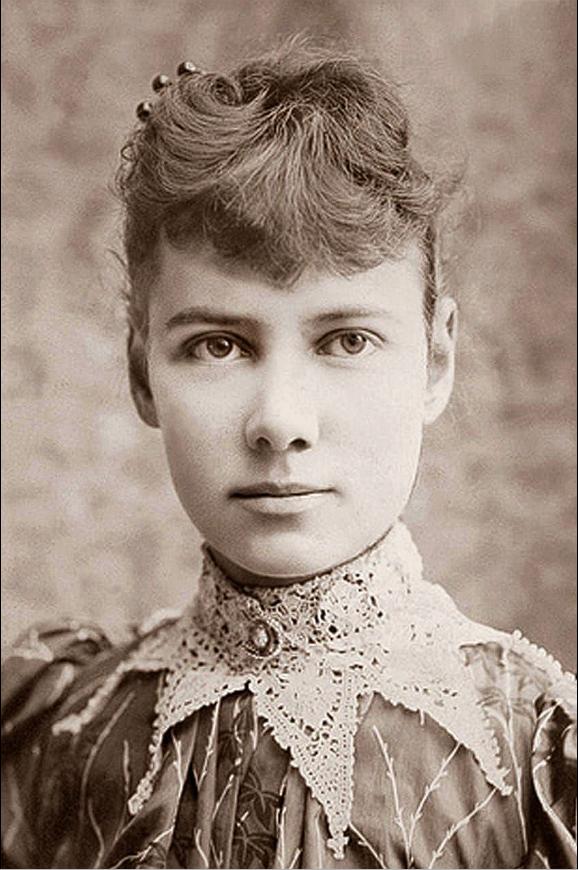“At the close of the 19th century, Elizabeth Cochrane, known to the world as Nellie Bly, emerged as a transformative figure in journalism. Her approach, marked by daring undercover investigations and record-breaking feats, challenged the norms of her time and reshaped the very definition of reporting. Though her active career was relatively short, her impact resonated far beyond her years.”
A Bold Beginning: Challenging Societal Constraints
- The Spark of Rebellion:
- Nellie Bly’s entry into journalism was ignited by a fierce rebuttal against the limited roles prescribed for women. When a Pittsburgh newspaper published an article confining women to domestic duties, she responded with a passionate, anonymous letter.
- This act of defiance caught the editor’s attention, leading to her employment and the adoption of her pen name, “Nellie Bly,” derived from a popular song. This name, while colorful, was also a marker of the times, as woman writers often where forced to use pseudonyms.
- Early Forays into Reporting:
- Despite her ambitions for investigative work, Bly was initially relegated to covering “feminine” topics. However, she quickly pushed against these constraints, producing hard-hitting reports on the harsh conditions faced by female factory workers.
- Her frustration with these limitations culminated in a solo journey to Mexico, where her dispatches on the lives of the working class drew the ire of local authorities, forcing her to flee.
- Breaking the Mold:
- The era in which Nellie Bly lived was one of strict societal constraints for women. They were expected to remain within the domestic sphere, their voices often silenced. Bly’s emergence was a breath of fresh air, a challenge to the status quo. Her determination to report on the realities of life, especially for those marginalized, set her apart.
Groundbreaking Investigations: Exposing Systemic Injustice
- Ten Days in a Mad-House:
- Nellie Bly’s most famous investigation involved her undercover stay in the Blackwell’s Island Insane Asylum. Feigning insanity, she spent ten harrowing days documenting the institution’s horrific conditions.
- Her subsequent exposé in the New York World caused a national sensation, leading to widespread reforms in mental health care. This story not only revealed the cruelty of the asylum but also highlighted the power of investigative journalism to affect change.
- Around the World in Seventy-Two Days:
- Inspired by Jules Verne’s novel, Bly embarked on a solo journey around the world, aiming to break the fictional 80-day record. This feat of endurance and determination captured the world’s imagination.
- Her 72-day journey, undertaken with minimal preparation, showcased her resourcefulness and tenacity. The New York World’s rival newspaper, not to be outdone, sent their own journalist, Elizabeth Bisland, on a competing journey, adding an element of rivalry and excitement.
- Speaking Truth to Power:
- Through her reporting, Nellie Bly shone a light on the dark corners of society, exposing corruption and injustice. Her work went beyond mere reporting; it was a form of activism, aimed at holding those in power accountable.
Later Life and Enduring Legacy:
- A Shift in Focus:
- At the age of 31, Bly surprised many by marrying millionaire Robert Seaman and temporarily retiring from journalism. During this period, she took on the challenge of managing his manufacturing business, even obtaining patents for her own inventions.
- While she proved to be a capable businesswoman, her true passion remained in storytelling. When her husband’s business faced difficulties, she returned to her journalistic roots.
- War Correspondent:
- With the outbreak of World War I, Bly once again defied expectations, becoming one of the first female war correspondents. She ventured into dangerous war zones, bringing the realities of conflict to her readers.
- Her war correspondence went beyond reporting on battles; she focused on the human stories, the experiences of soldiers and civilians caught in the crossfire.
- A Lasting Inspiration:
- Nellie Bly’s life and work continue to inspire generations of journalists and women. She demonstrated that courage, determination, and a commitment to truth can overcome even the most daunting obstacles. Her legacy is one of breaking barriers and challenging the status quo.
Additional Information:
- Overcoming Obstacles:
- As a female journalist in a male-dominated field, Nellie Bly faced constant challenges and opposition. She had to fight for recognition and respect, proving her abilities time and again.
- Her unconventional reporting methods, particularly her undercover investigations, were often met with skepticism and criticism.
- Transforming Journalism:
- Nellie Bly’s work revolutionized investigative journalism, setting a new standard for immersive and impactful reporting. She showed that journalists could be agents of social change.
- Her commitment to exposing injustice and advocating for the marginalized left a lasting impact on the field.
Conclusion:
“Nellie Bly’s life stands as a testament to the power of journalism to expose truth and inspire change. Her courage, determination, and unwavering commitment to justice redefined the role of a journalist and left a legacy that continues to inspire.”
